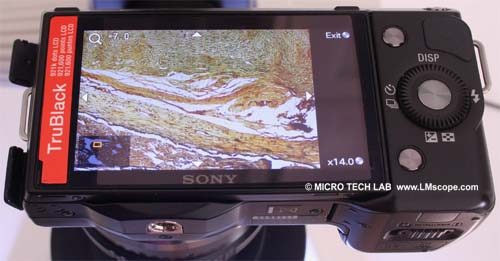

Sony NEX-5 and Sony NEX-3 in microscopy
With the two NEX-5 and NEX-3 camera models, Sony has successfully joined in with the current trend for small mirrorless system cameras. The main target group for these cameras is comprised of users who find operating digital SLR cameras too complicated, but who require the kind of high-quality picture that compact cameras are unable to deliver.

Key technical data:
* 14.2 megapixels
* Mirrorless and shutterless (no vibrations and blurring)
* Sensor in APS-C format
* Live View – display on HDMI port
* Full HD videos (Sony NEX-5)
* AVCHD and MP4 memory format
Mirrorless system cameras make photography easier in many respects. Their size is similar to that of zoom compact cameras (the Sony NEX-5 camera, for example, weighs just 287 g!) with the great advantage that interchangeable lenses and other system accessories such as flash units, etc. can be used. The image quality achieved stands up well in comparison with that of the significantly larger digital SLR cameras and the creative functions also come close to matching those offered by larger and more expensive systems.
With its 14.2 megapixels, the Sony NEX-5 (and Sony NEX-3) is extremely well suited to challenging microscopy work. Moreover, the fact that the camera has no mirror enhances the image quality, since when the shutter is released there are no vibrations and consequently no blurring.
It also has an excellent resolution capacity, comparable with that of the Olympus E5. In addition, the fact that any videos recorded with the camera are in full HD and, like camcorders, have an AVCHD memory format, is also very convenient (only Sony NEX-5). The Live View output can be displayed in HD quality via an HDMI port. This means that the benefits of modern HD, LCD and plasma monitors can be fully exploited. The camera possesses a range of further useful features, such as “anti-motion-blur”, a tool to counteract blurring. It takes six photographs in quick succession and stacks them together to produce a single image. This offers significant advantages if the user wishes to capture moving objects. The depth of field can be regulated by simply turning the adjusting ring; the camera then selects the most suitable aperture itself.
In microscopy, the magnification function, which offers a choice of 7x or 14x magnification, is very helpful. This function makes it possible to precisely adjust the focus. The microscopy image at the end of this report was taken using the 14x magnification function.
The Sony NEX-5 offers the possibility of displaying a Live View picture directly on an HD-capable monitor or even a projector (for lectures and talks) via the HDMI interface. This is particularly advantageous if several persons are working together and discussing the slide.
For the purposes of microscope photography, we would prefer it if there was also a remote control software program (tethered shooting) to enable remote control directly from the PC. As it is, the user has to make do either with the camera’s self-timer or should buy the appropriate remote control, which we would recommend.
Working on a microscope does not require a lens. This poses a small problem, which, however, can be easily overcome with a small adjustment to the settings in the menu. If the lens is unscrewed, the display flashes up the following message: “Cannot recognize lens. Attach it properly.”
Solution:
Select “Setup” in the menu.
In this menu point, activate “Release without lens”.
After this menu item has been successfully activated, the following text appears on the camera’s screen:
Now there is nothing to prevent the user from taking photographs through the microscope! This image was taken using the 14x magnification function. As the display does not have the same number of pixels as the sensor, it is expedient to zoom out a certain part of the slide using the magnification function.
We offer suitable adapter solutions for all microscopes. You can use our database to select the right LM adapter.
Conclusion:
Small, handy, user-friendly camera that is ideally suited to microscopy. Gets top marks for its very high resolution capacity, a large sensor, magnification function and the option to produce HD videos. The camera also offers the possibility of displaying a Live View picture on an HD-capable monitor via the HDMI interface, which is not currently standard for digital system cameras. The only shortcoming at present is the lack of remote control software.
Stand: 03.02.2011
New LM Digital Adapter for: Sony Alpha 9 III / Sony Alpha 7R V / Sony Alpha 1 II / Sony Alpha 1 / Sony Alpha 9 II (ILCE-9M2) / Sony FX3 Cinema Line / Sony Alpha 9 / Sony Alpha 7R IV / Sony Alpha 7S II / Sony Alpha 7S III / Sony Alpha 7R III / Sony Alpha 7R II / Sony Alpha 7C / Sony Alpha 7S / Sony Alpha 7III / Sony Alpha 6700 / Sony Alpha 6600 / Sony Alpha 6400 / Sony Alpha 6100 / Sony ZV-E10 / Sony Alpha 6300 / Sony Alpha 6500 / Sony Alpha 99 II (SLT-A99 II) / Sony Alpha 77 II / Sony Alpha 7R / Sony Alpha 7 /




